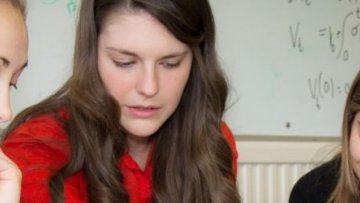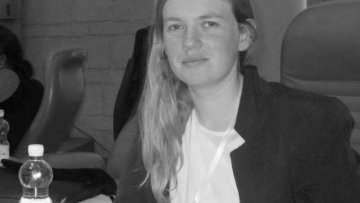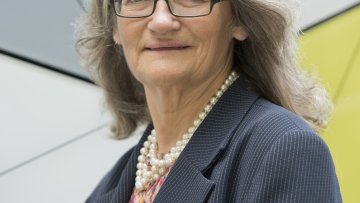Oxford Mathematics's Ulrike Tillmann has been elected a member of the German National Academy of Sciences. The Academy, Leopoldina, brings together the expertise of some 1,500 distinguished scientists to bear on questions of social and political relevance, publishing unbiased and timely scientific opinions.
The Athena SWAN charter was establised in 2005 to encourage and recognise commitment to advancing the careers of women in science. In 2013 the Mathematical Institute here in Oxford was awarded a bronze medal and now, four years later, we are pleased to announce that we have been upgraded to silver.
Pattern Formation in Non-Local Systems with Cross-Diffusion
Abstract
Multi-agent systems in nature oftentimes exhibit emergent behaviour, i.e. the formation of patterns in the absence of a leader or external stimuli such as light or food sources. We present a non-local two species crossinteraction model with cross-diffusion and explore its long-time behaviour. We observe a rich zoology of behaviours exhibiting phenomena such as mixing and/or segregation of both species and the formation of travelling pulses.
14:30
On the number of distinct vertex sets covered by cycles
Abstract
Komlós conjectured in 1981 that among all graphs with minimum degree at least $d$, the complete graph $K_{d+1}$ minimises the number of Hamiltonian subsets, where a subset of vertices is Hamiltonian if it contains a spanning cycle. We prove this conjecture when $d$ is sufficiently large. In fact we prove a stronger result: for large $d$, any graph $G$ with average degree at least $d$ contains almost twice as many Hamiltonian subsets as $K_{d+1}$, unless $G$ is isomorphic to $K_{d+1}$ or a certain other graph which we specify. This is joint work with Hong Liu, Maryam Sharifzadeh and Katherine Staden.
14:30
Families with few k-chains
Abstract
A central theorem in combinatorics is Sperner’s Theorem, which determines the maximum size of a family in the Boolean lattice that does not contain a 2-chain. Erdos later extended this result and determined the largest family not containing a k-chain. Erdos and Katona and later Kleitman asked how many such chains must appear in families whose size is larger than the corresponding extremal result.
This question was resolved for 2-chains by Kleitman in 1966, who showed that amongst families of size M in the Boolean lattice, the number of 2-chains is minimized by a family whose sets are taken as close to the middle layer as possible. He also conjectured that the same conclusion should hold for all k, not just 2. The best result on this question is due to Das, Gan and Sudakov who showed roughly that Kleitman’s conjecture holds for families whose size is at most the size of the k+1 middle layers of the Boolean lattice. Our main result is that for every fixed k and epsilon, if n is sufficiently large then Kleitman’s conjecture holds for families of size at most (1-epsilon)2^n, thereby establishing Kleitman’s conjecture asymptotically (in a sense). Our proof is based on ideas of Kleitman and Das, Gan and Sudakov.
Joint work with Jozsef Balogh.
14:30
Some Extremal Results on Cycles in Hypergraphs
Abstract
Many extremal results on cycles use what may be called BFS method, where a breath first search tree is used as a skeleton to build desired structures. A well-known example is the Bondy-Simonovits theorem that every n-vertex graph with more than 100kn^{1+1/k} edges contains an even cycle of length 2k. The standard BFS method, however, is not easily applicable for supersaturation problems where one wishes to show the existence of many copies of a given subgraph. The method is also not easily applicable in the hypergraph setting.
In this talk, we focus on some variants of the standard BFS method. We use one of these in conjunction with some useful general reduction theorems that we develop to establish the supersaturation of loose (linear) even cycles in linear hypergraphs. This extends Simonovits' supersaturation theorem on even cycles in graphs. This is joint work with Liana Yepremyan.
If time allows, we will also discuss another variant (joint with Jie Ma) used in the study of Berge cycles of consecutive lengths in hypergraphs.
14:30
Monochromatic Infinite Sumsets
Abstract
It is well known that there is a finite colouring of the natural numbers such that there is no infinite set X with X+X (the pairwise sums from X, allowing repetition) monochromatic. It is easy to extend this to the rationals. Hindman, Leader and Strauss showed that there is also such a colouring of the reals, and asked if there exists a space 'large enough' that for every finite colouring there does exist an infinite X with X+X monochromatic. We show that there is indeed such a space. Joint work with Imre Leader.
16:00
Non-abelian reciprocity laws and higher Brauer-Manin obstructions
Abstract
Kim's iterative non-abelian reciprocity laws carve out a sequence of subsets of the adelic points of a suitable algebraic variety, containing the global points. Like Ellenberg's obstructions to the existence of global points, they are based on nilpotent approximations to the variety. Systematically exploiting this idea gives a sequence starting with the Brauer-Manin obstruction, based on the theory of obstruction towers in algebraic topology. For Shimura varieties, nilpotent approximations are inadequate as the fundamental group is nearly perfect, but relative completions produce an interesting obstruction tower. For modular curves, these maps take values in Galois cohomology of modular forms, and give obstructions to an adelic elliptic curve with global Tate module underlying a global elliptic curve.
11:00
On fields with the absolute Galois group of Q
Abstract
.. showing that a field K is isomorphic to Q if it has the same absolute Galois group and if it satisfies a very small additional condition (very similar to my talk 2 years ago).






